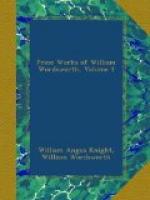’While the villains of Low Furness were thus distributed over the land, and employed in agriculture; those of High Furness were charged with the care of flocks and herds, to protect them from the wolves which lurked in the thickets, and in winter to browze them with the tender sprouts of hollies and ash. This custom was not till lately discontinued in High Furness; and holly-trees were carefully preserved for that purpose when all other wood was cleared off; large tracts of common being so covered with these trees, as to have the appearance of a forest of hollies. At the Shepherd’s call, the flocks surrounded the holly-bush, and received the croppings at his hand, which they greedily nibbled up, bleating for more. The Abbots of Furness enfranchised these pastoral vassals, and permitted them to enclose quillets to their houses, for which they paid encroachment rent.’—West’s Antiquities of Furness.
However desirable, for the purposes of defence, a numerous population might be, it was not possible to make at once the same numerous allotments among the untilled vallies, and upon the sides of the mountains, as had been made in the cultivated plains. The enfranchised shepherd or woodlander, having chosen there his place of residence, builds it of sods, or of the mountain-stone, and, with the permission of his lord, encloses, like Robinson Crusoe, a small croft or two immediately at his door for such animals as he wishes to protect. Others are happy to imitate his example, and avail themselves of the same privileges: and thus a population, mainly of Danish or Norse origin, as the dialect indicates, crept on towards the more secluded parts of the vallies. Chapels, daughters of some distant mother church, are first erected in the more open and fertile vales, as those of Bowness




